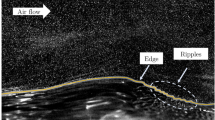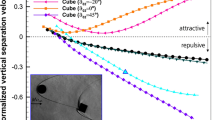Abstract
A previously published technique for using tethered spherical balloons as anemometers for measuring light low-level winds has been further developed. Earlier data on the relationship between the aerodynamic drag coefficient and the Reynolds number of spherical rubber balloons were combined with a large number of new data and re-analysed; and the errors in the relationship were estimated. The results allowed a more accurate calculation of wind speed from the deflection of a tethered balloon from the vertical. When combined with a new technique for calculating the effects of the tether, this enabled light to moderate low-level winds at fixed heights up to 600 m or more to be measured with simple, cheap, and readily mobile equipment; and a slight modification of the technique allowed measurement of winds in and above fog. Wind speeds measured by the ballon technique showed reasonably good agreement with measurements by an anemometer carried beneath the balloon.
Similar content being viewed by others
Abbreviations
- a, b, c :
-
Coefficients in the relationship between lnC d and lnR
- A :
-
Quantity under square root in solution for lnV whena≠0
- C d :
-
Wind drag coefficient for balloon
- C dc :
-
Value ofC d given by calibration curve of Table I
- D:
-
Dynamic wind pressure force on balloon
- F:
-
Buoyant free lift of balloon with load
- Re:
-
Reynold's number of balloon (sphere)
- R :
-
= Re/105
- r :
-
Radius of sphere
- T:
-
Tension in tether
- V :
-
Wind speed
- δ83(θβ):
-
=(lnC dc -lnC d ) when θβ⩾83° , or 0 for other θβ
- ∈:
-
Error in lnC d
- θβ :
-
Elevation of tether where attached to balloon
- θμ :
-
Elevation of balloon from ground tether point
- μ:
-
Molecular viscosity of air
- π:
-
Ratio of circumference to diameter of circle
- ρ:
-
Density of air
References
Batchelor, G. K.: 1970,An Introduction to Fluid Dynamics Cambridge University Press, Cambridge, pp. 341–343.
Francey, R. J. and Sahashi, K.: 1982, ‘The Overestimation of Windspeeds from Cup Anemometers’,J. Meteorol. Soc. Japan 60, 821–823.
Kaganov, E. I. and Yaglom, A. M.: 1976, ‘Errors in Wind-Speed Measurements by Rotation Anemometers’,Boundary-Layer Meteorol. 10, 15–34.
Moriarty, W. W.: 1980, ‘Survey of Low Level Winds and Air Dispersion Characteristics of the Albury-Wodonga Area’, Australian Bureau of Meteorology Bulletin No. 50, Aust. Govt. Publishing Service, Canberra.
Moriarty, W. W.: 1987, ‘Temperature Corrections for the Australian Radiosonde when Used as a Tethersonde’, Technical Report No. 60, Bureau of Meteorology, Melbourne.
Moriarty, W. W.: 1992, ‘Tether Corrections for Tethered Balloon Wind Measurements’Boundary-Layer Meteorol. 61, 407–417.
Saha, K. R.: 1956, ‘The Aerodynamic Resistance of Tethered Balloons’,Indian J. Meteorol. Geophys. 7, 241–252.
Tapp, R. G. and Lile, R. C.: 1978, ‘A New Tethersonde System for Remote Measurement of Wind and Temperature’,Boundary-Layer Meteorol. 15, 465–479.
Author information
Authors and Affiliations
Rights and permissions
About this article
Cite this article
Moriarty, W.W. An improved calibration for tethered balloon wind measurements. Boundary-Layer Meteorol 63, 183–196 (1993). https://doi.org/10.1007/BF00705382
Revised:
Issue Date:
DOI: https://doi.org/10.1007/BF00705382




